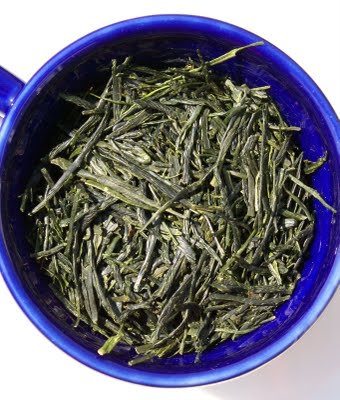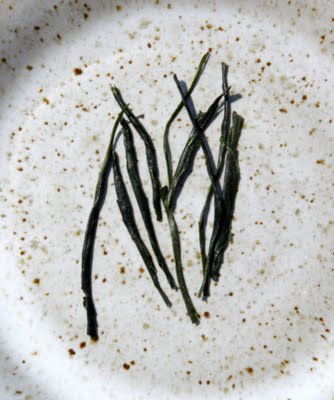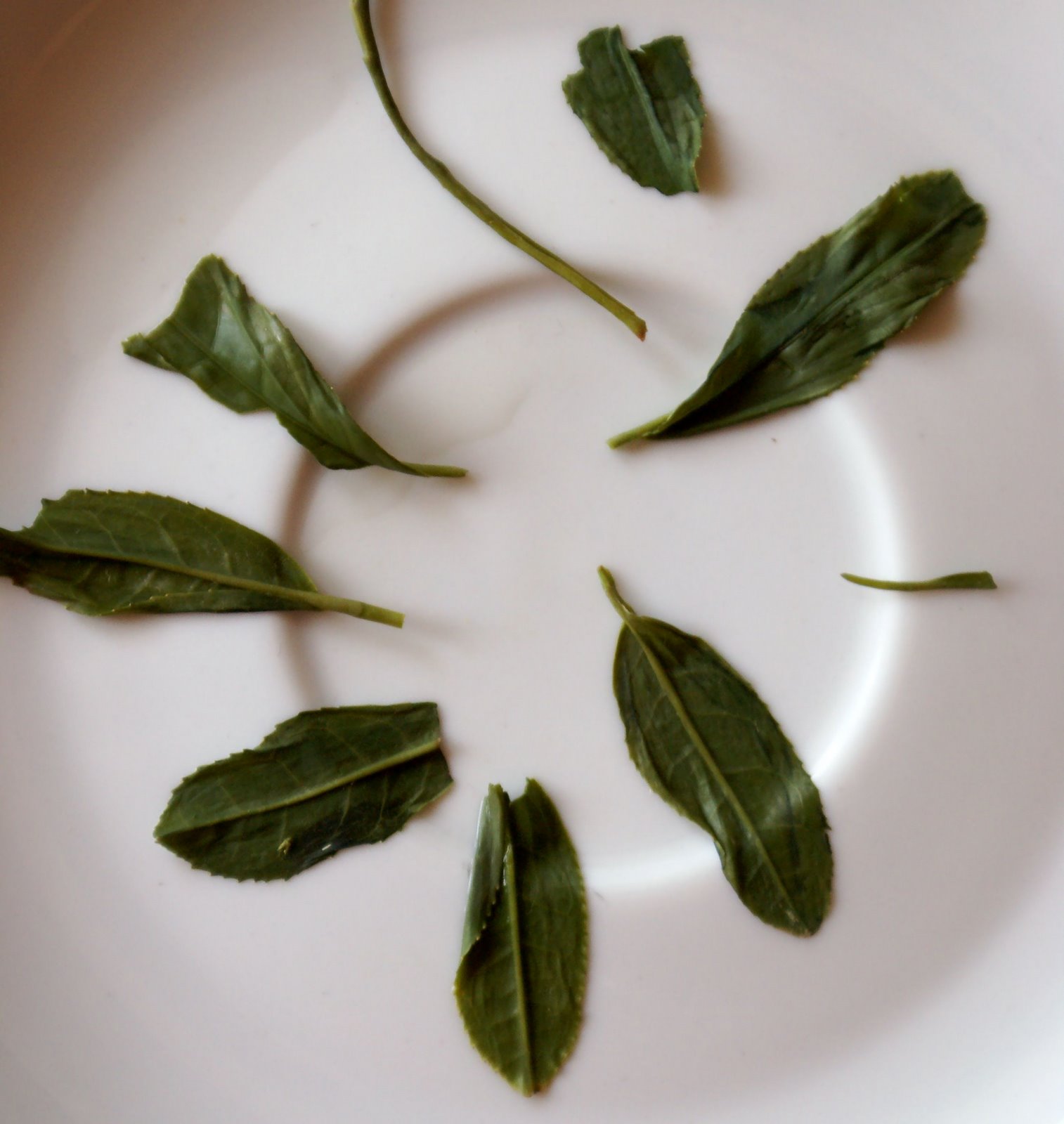(5) 2009 Uji Gold Shincha
Posted on 2 August 2009
2008 Gyokuro Kame-Jiru-Shi (O-Cha)
2008 Gyokuro Tama Homare (Marukyu)
2008 Kabusecha Takamado (Marukyu)
2008 Karigane Otowa (Marukyu)
2008 Sencha Miyabi (O-Cha)
2009 Shincha Fukamushi Supreme (O-Cha)
2009 Shincha Shigaraki (Marukyu)
2009 Shincha Shuei (Marukyu)
2009 Shincha Yutakamidori (O-Cha)
Package aside, the dry leaves are a joy to look at:
 We are on totally different territory than the trio of O-Cha releases reviewed in the last few days (see links at top of post). This is very definitely an asamushi [short-steamed] tea, and the leaves are impeccable, dark emerald in colour, 100% intact, almost exclusively whole. It’s a rare sight among Japanese teas. It has an enjoyable aroma, rather light and elegant, sweet (melon), ungrassy but vaguely reminiscent of spinach, very lightly roasted; compared to the other 2009 shincha teas reviewed in this series, this Uji Gold introduces a sweet-spicy note of vanilla.
We are on totally different territory than the trio of O-Cha releases reviewed in the last few days (see links at top of post). This is very definitely an asamushi [short-steamed] tea, and the leaves are impeccable, dark emerald in colour, 100% intact, almost exclusively whole. It’s a rare sight among Japanese teas. It has an enjoyable aroma, rather light and elegant, sweet (melon), ungrassy but vaguely reminiscent of spinach, very lightly roasted; compared to the other 2009 shincha teas reviewed in this series, this Uji Gold introduces a sweet-spicy note of vanilla. The dry leaf tells a lot about this tea’s characteristics and pretty much preannounces the ups and downs of actually brewing it. As much as I am aesthetically admirative of the leaf quality here, it’s a difficult tea to interpret. It has little to do with Japanese sencha as we know it. Brewed with standard parameters (2g / 120ml / water at 70C / 60–90 seconds) this yields a light greenish-golden colour, and the profile is very close to a continental Chinese green tea. Light-bodied, unpungent, vegetal (in the sense of green beans and spinach, not the more usual grass), with little fruit (melon); only a very minor reminiscence of brothy umami. This profile continues through the second brewing (where Japanese greens usually pack in more oomph). Perhaps a bit of creaminess to the texture (egg custard).
The dry leaf tells a lot about this tea’s characteristics and pretty much preannounces the ups and downs of actually brewing it. As much as I am aesthetically admirative of the leaf quality here, it’s a difficult tea to interpret. It has little to do with Japanese sencha as we know it. Brewed with standard parameters (2g / 120ml / water at 70C / 60–90 seconds) this yields a light greenish-golden colour, and the profile is very close to a continental Chinese green tea. Light-bodied, unpungent, vegetal (in the sense of green beans and spinach, not the more usual grass), with little fruit (melon); only a very minor reminiscence of brothy umami. This profile continues through the second brewing (where Japanese greens usually pack in more oomph). Perhaps a bit of creaminess to the texture (egg custard).
Infusion no. 1: 60 seconds at 70C.
Logically for a whole leaf tea, where the leaf surface to water ratio is far larger than in a fragmented leaf fukamushi [long-steamed] tea such as this, it’s reasonable to increase leaf quantity, water temperature, or both in order to get better extraction and more depth of flavour. From these options, a higher 80–85C temperature is fine, with more palate presence and length (but a finish that’s bit hard), but I’ve been happier with a higher dosage. Move from 2 to 4 grams of dry leaf in the pot (60 seconds for the first brewing, shorter afterwards) and you’re getting a totally different animal. Deeper in colour (though still yellowish rather than jade-green), much more saline and mineral, this reminded me of some avant-garde white wines from Alsace or Friuli in its full terroir presence. I’m interpreting this as a signature of Uji, Japan’s most renowned tea growing location. Still not exactly a typical Japanese sencha, again reminiscent of something more continental, but now a really exciting tea.
As it stands, I found this an eye-opener. Too often we are stuck with what we deem is ‘typical’: an important concept in interpreting any agricultural product but dangerous when it starts to handicap truly individual ones. This 2009 Uji Gold is precisely that: a high-quality product with a distinctive style. I’m sorry to see my 50g pack drawing to an inevitable end.
No mistake: this is Japanese shincha.


